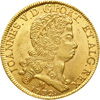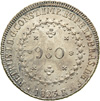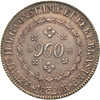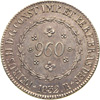
|
Sale 46
The Millennia Collection
| Lot |
Photo |
Description |
Realized |
Lot 968 |
 |
Brazil. Gold 20,000 Reis, 1725 (Minas Gerais). Fr-33; KM-117; Gomes-38.02. 53.62 grams. Joao V, 1706-1750. Crowned arms and value. Reverse: Cross of Jerusalem, M's in angles. NGC graded MS-62.
Of the two, Portugal and Spain, Portugal was the quickest in exploiting the commercial opportunities in her new lands. Increasing friction between these two maritime powers had already led to a Papal bull by Alexander VI, at Spain's instigation, delineating the non-competing zones of influence these countries would have over the non-Christian world. The issue was further formalized by the Treaty of Tordesillas in 1493. The Papal bull had given Spain the entire New World, but the new treaty had caused the line of demarcation to be moved further west of the Canary Islands, by about 370 leagues. Geographical knowledge of the area was still very scanty at the time, and so the debate remains whether the Portuguese were aware of South American lands awaiting their exploitation. In any event, Portugal had discovered (by accident?) and claimed Brazil by 1500, and continued further exploration at a rapid pace. By mid century, settlements were already established, and Brazil had been elevated to the status of a royal colony.
If the kings of Portugal felt at all short changed by the demarcation treaty, events would prove otherwise. In 1690 gold was discovered in the area that became known as Minas Gerais ("General Mines"). This would be followed by discoveries of precious gems. During the 18th century, this little pocket of land would produce a torrent of gold, diamonds, and emeralds for the kings of Portugal. The above 20,000 Reis was a short-lived denomination, lasting three brief years, and evocative of this gusher of wealth. While its employ and influence was mostly limited to the New World, it remained the largest regional gold coin issued and circulating in its time - weighing in at slightly over two Spanish 8 Escudos, with a pure gold weight of nearly 1.6 ounces.
Estimated Value $5,000 - 6,000.
View details and enlarged photos
| Realized
$13,225 |
Lot 969 |
 |
Brazil. 12,800 Reis, 1732-M (Mina Gerais). Fr-55; KM-139; Gomes-56.18. 28.64 grams. Joao V, 1706-1750. Laureate head right. Reverse: Crowned Italic arms. Matte to lustrous devices on very pristine fields, rich with cartwheel luster. Rare this choice. NGC graded MS-64.
The 12,800 Reis was an exact doubling of the standard gold coin of the realm, the 6400 Reis. The lighter coin was also known as the Peca, the Dobra, and the "Joe". Yet the 12,800 denomination was apparently a not well received issue. It only saw service under John V, from 1727 to 1733, with all mintages seemingly fairly modest to extremely rare. So, while these larger multiples did not find much favour in the international banking and commerce communities, they nevertheless provided a convenient means for absorbing the gold that was pouring forth from the province of Minas Gerais. (It is estimated that Brazil's gold production for the 18th century amounted to as much as two million pounds!) The larger denominations circulated extensively in the Western Hemisphere, and especially North America.
Estimated Value $5,000 - 6,000.
Illustrated in Money of the World, coin 152.
View details and enlarged photos
| Realized
$18,400 |
Lot 970 |
 |
Brazil. 6400 Reis, 1738-R (Rio). Fr-46; KM-149; Gomes-56.18. 14.20 grams. Joao V, 1706-1750. Laureate head right. Reverse: Italic arms. A little die clashing evident on reverse. Lustrous. Very rare this choice. NGC graded MS-63.
In 1720 Joao V (John, or Joannes V) authorized a new mint at Villa Rica de Ouro Preto, in the flourishing mining region of Minas Gerais. Along with mint in Rio, production would begin on a series of larger gold coins, including some heavier multiples. The series would include, at a slightly later date to those struck in Lisbon, Portugal's first royal portraiture coinage. While these coins did not have the universal success of Portugal's earlier and lighter moidores, they nevertheless circulated widely in North America. There the coins became known as "Joes," for the royal names of Joannes and Josephus, whose rulers and portraits figured so prominently on them.
Estimated Value $1,500 - 2,000.
View details and enlarged photos
| Realized
$4,830 |
Lot 971 |
 |
Brazil. 6400 Reis, 1780-R (Rio). Fr-76; KM-199.1; Gomes-25.04a. Maria I and Pedro III. Lustrous. NGC graded MS-64.
Backed by its Brazilian and African gold resources, Portugal's Joao V, 1706-1750, initiated in 1723 a gold coinage to compete with Spain's famed golden escudos, and based its weight on that of the escudo. This was reflected in Brazil by the striking of two series of coins, one for internal currency, and one based on equivalency to the escudo. Thus the Brazilian 6400 Reis was equal to Portugal's 4 Escudos, or Peca.
Estimated Value $1,500 - 2,000.
View details and enlarged photos
| Realized
$4,830 |
Lot 972 |
 |
Brazil. 960 Reis, 1810-M (Minas Gerais). WR-1; Eliz-4; KM-307.2. 26.75 grams. John, Prince Regent, 1799-1818. Crowned arms, value in field. Reverse: Globe before cross. Overtstruck on a Bolivian 8 Reales of Charles IV. The new obverse die showing a severe crack. Appealing old toning, tending to the blue.
A classic rarity of Brazil. An extremely rare two year issue, and the only type from this mint. A boldly struck example. NGC graded EF-40.
Minas Gerais is the second most populous of the Brazilian states today. The name is a shortened form of Minas dos Matos Gerais. which translates to mines of the general woods. Gold was discovered in the area in 1693, and thousands of colonists headed inland in one of the first gold rushes in history. The 18th century capital of the state, Vila Rica, was one of the largest cities in all the Americas. Today, with the gold mines exhausted, the newer city of Belo Horizonte, is far more important.
Estimated Value $5,000 - 6,000.
View details and enlarged photos
| Realized
$7,188 |
Lot 973 |
 |
Brazil. 960 Reis, 1821-R (Rio de Janerio). WR-2; Eliz-39a; KM-326.1. 26.75 grams. John VI, 1818-1822. Crowned wreath, value and date wthin. Reverse: Arms on globe, before cross. Overstruck on a Ferdinand VII 8 Reales, the devices with bold detail. The fields with almost pebbly texture, showing bright cartwheel luster. NGC graded MS-65.
Estimated Value $250 - 300.
View details and enlarged photos
| Realized
$891 |
Lot 974 |
 |
Brazil. 960 Reis, 1823-R (Rio de Janerio). WR-2; Eliz-39a; KM-326.1. 26.93 grams. Peter I, 1822-1831. Circular wreath, eight rosettes and value wthin. Reverse: Crowned imperial arms, wreath around. Overstruck on Charles IV 8 Reales. Crisp bold strike. The obverse field softly lustrous, with "orange peel" texture; the reverse more reflective. Lightly toned. First year of type. NGC graded MS-64.
An interesting, and little known fact about the city of Rio de Janeiro, is that the first non-Portuguese immigrants to arrive were the Swiss. They arrived in 1818, and founded the city of Nova Friburgo. They were soon followed by the Germans. Rio prospered as the port where the gold from Minas Gerais was brought to be then shipped to Portugal.
Estimated Value $300 - 350.
View details and enlarged photos
| Realized
$776 |
Lot 975 |
 |
Brazil. 960 Reis, 1832-R (Rio). KM-385; Eliz-51; Cr-182. Rio mint. Pedro II. Mintage of only 3,039. A very nice example that rarely appears in choice quality. Well struck with lovely surfaces and nicely toned. Rare type and very rare in grade. NGC graded MS-63.
Estimated Value $2,000 - 2,500.
View details and enlarged photos
| Realized
$2,875 |
Lot 976 |
 |
Brazil. 960 Reis, 1832-R (Rio). KM-385; Eliz-51; Cr-182. Rio mint. Pedro II. Mintage of only 3,039. A very nice example that rarely appears in choice quality. Well struck with lovely surfaces and nicely toned. Rare type and very rare in grade. NGC graded MS-63.
Pedro II's "dollars" like his two predecessors, were struck over Bust type Spanish American coinage thus assuring their acceptance as trade coins.
Estimated Value $2,000 - 2,500.
View details and enlarged photos
| Realized
$3,240 |
Lot 977 |
 |
Brazil. 6400 Reis, 1832-R (Rio). Fr-115; KM-387.1. Pedro II. Bust right. Reverse: Imperial arms and value. Lustrous. Scarce. NGC graded AU-58.
Pedro was the last Brazilian Emperor, and the first Brazilian ruler to be native born. Exceptionally intelligent and forward thinking, he ascended the throne at age five. The first years of his rule were administered by a regency, but at age fourteen, being so advanced, the Brazilian General Assembly abolished the regency, and declared Pedro fit to govern. Pedro reigned as Emperor for 49 years. He established paved roads, installed telephones and telegraphy cable, and attempted to have steam locomotives placed throught the vast country. It can easily be argued that Pedro was the most able ruler in South America in the 19th century.
Estimated Value $1,250 - 1,500.
View details and enlarged photos
| Realized
$2,415 |
Lot 978 |
 |
Brazil. 20,000 Reis, 1851. Fr-119; KM-461. Pedro II. Bust in Coronation Robe. Reverse: Imperial arms. "Papo de Tucano" type. NGC graded MS-62.
The Paraguyan War of 1864, although not initiated by Brazil, was Pedro's biggest public relations disaster. The war, also known as the War of the Triple Alliance, was started by the Paraguayan dictator, Francisco Loano Lopez. His aggresive attacks resulted in the bloodiest war in South American history, with over 400,000 killed. Brazil lost over 100,000 men, and many blamed the Emperor for these losses. Indirectly, the war resulted in the abolition of the Empire and the establishment of the Brazilian Republic in 1889.
Estimated Value $600 - 700.
View details and enlarged photos
| Realized
$1,265 |
Lot 979 |
 |
Brazil. 20,000 Reis, 1853. Fr-121a; KM-468. Pedro II. Bearded older head. Proof-like with minor contact marks in fields. NGC graded MS-63.
Estimated Value $700 - 800.
View details and enlarged photos
| Realized
$1,110 |
Lot 980 |
 |
Brazil - Cuiaba. 960 Reis (1821). KM-350; Eliz-p.177, Type 3. Counterstamp Type C on Bolivia 1801-PP 8 Reales. Toned. Rare. NGC graded VF-30.
Cuiaba is the present capital of the state of Mato Grosso. It is located almost 1,000 miles west of Rio de Janeiro, and it distance, with the impossible travel conditions of the time, necessitated some form of local coinage. Since it was too difficult to transport the dies this distance, counterstamps were the logical solution. Cuiaba or Cuyaba, is the rarest of all the Brazilian counterstamps.
Estimated Value $1,500 - 1,750.
View details and enlarged photos
| Realized
$2,520 |
|
|